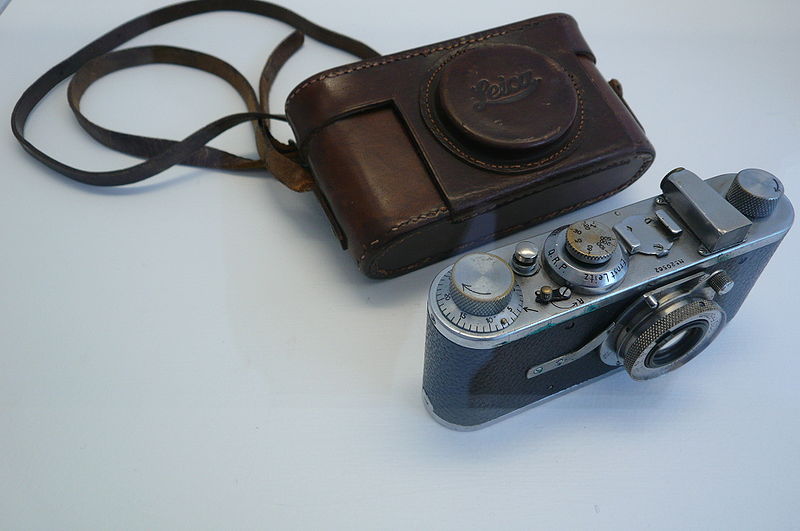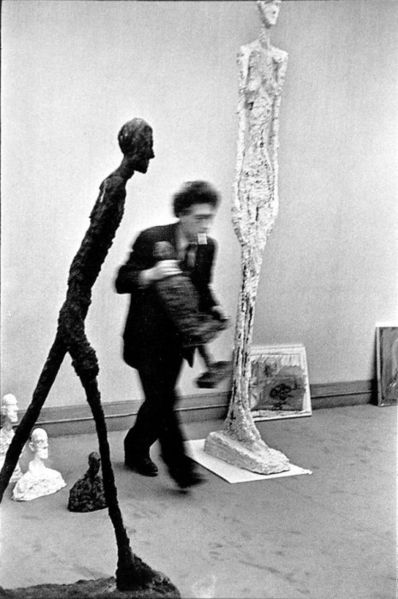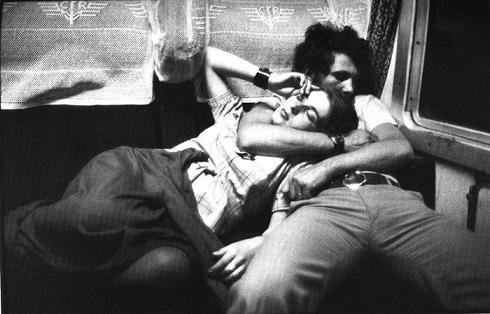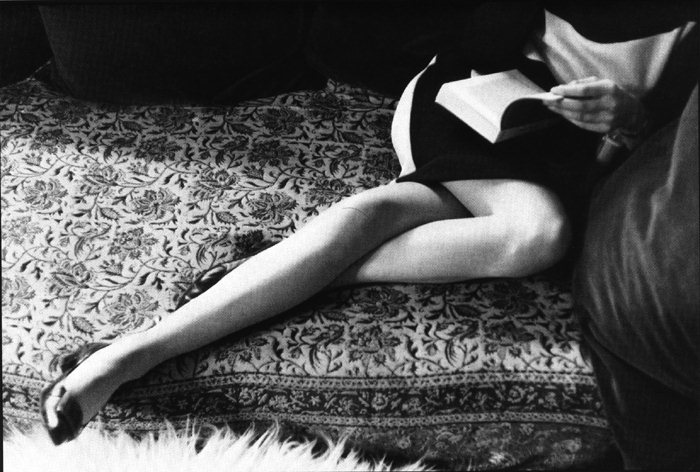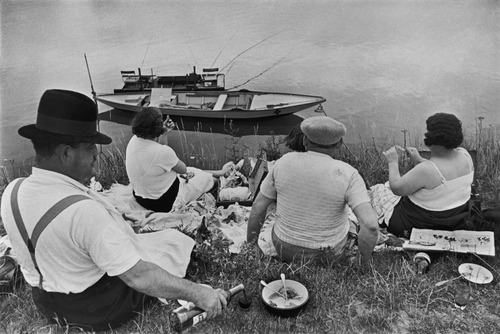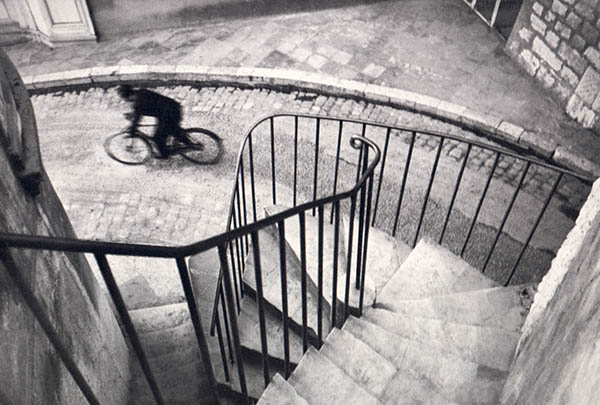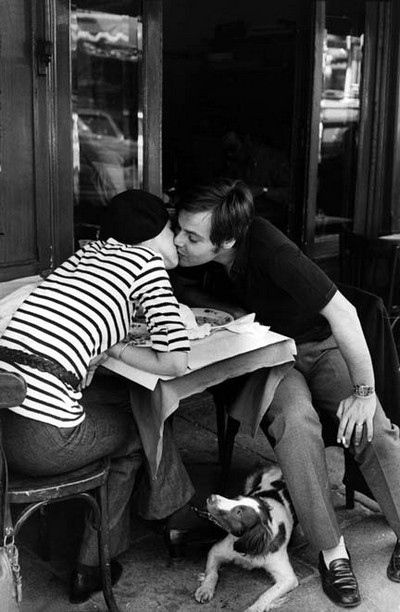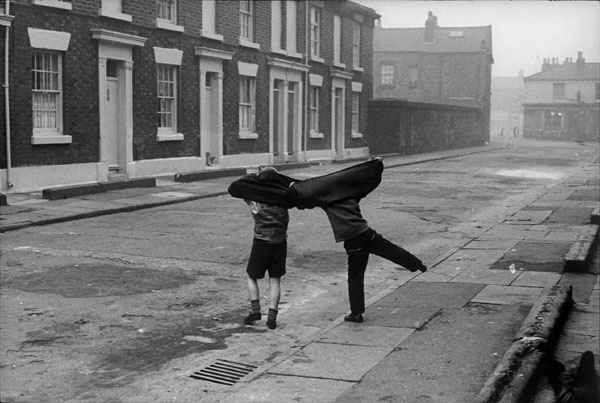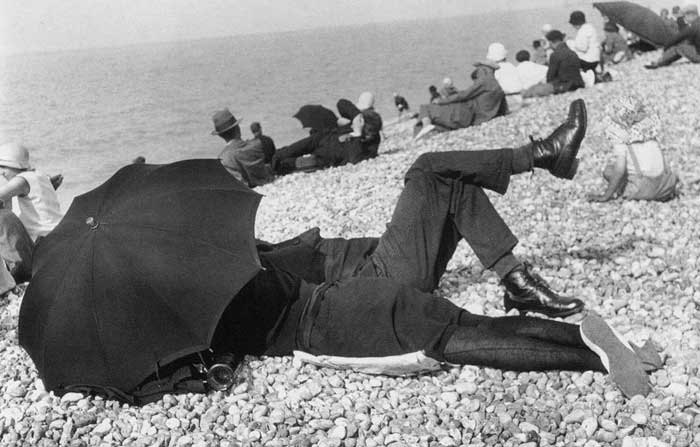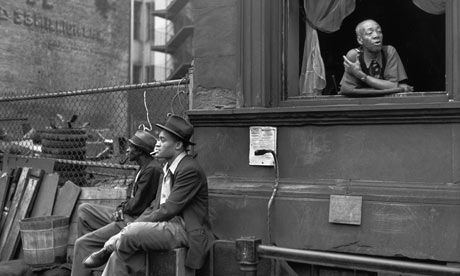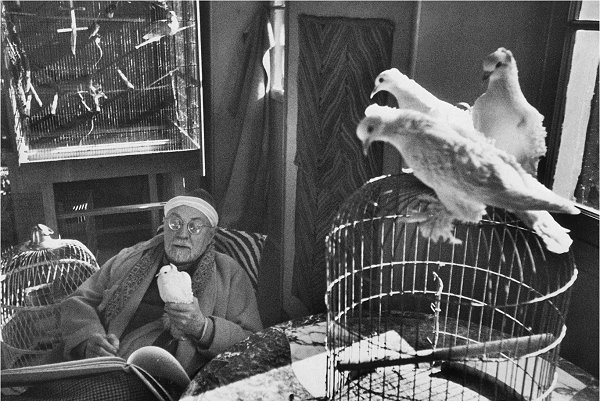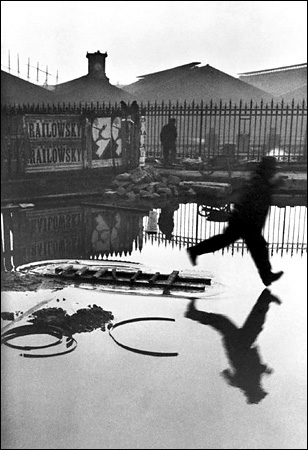<Back to Index>
- Physicist Bruno Pontecorvo, 1913
- Photographer Henri Cartier - Bresson, 1908
- Brigadier General of the U.S. Army William Selby Harney, 1800
PAGE SPONSOR
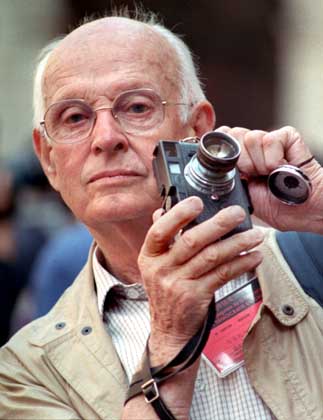
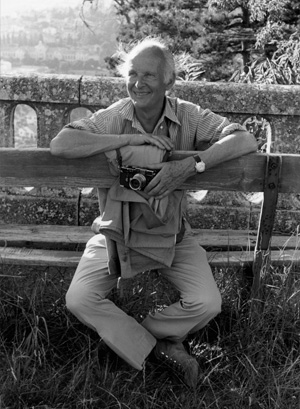
Henri Cartier-Bresson (August 22, 1908 – August 3, 2004) was a French photographer considered to be the father of modern photojournalism. He was an early adopter of 35 mm format, and the master of candid photography. He helped develop the "street photography" or "real life reportage" style that has influenced generations of photographers who followed.
Cartier - Bresson was born in Chanteloup - en - Brie, Seine - et - Marne, France, the oldest of five children. His father was a wealthy textile manufacturer, whose Cartier - Bresson thread was a staple of French sewing kits. His mother's family were cotton merchants and landowners from Normandy, where he spent part of his childhood. The Cartier - Bresson family lived in a bourgeois neighborhood in Paris, near the Europe Bridge. They were able to provide him with financial support to develop his interests in photography in a more independent manner than many of his contemporaries. Cartier - Bresson also sketched in his spare time. He described his family as "socialist Catholics".
As a young boy, Cartier - Bresson owned a Box Brownie, using it for taking holiday snapshots; he later experimented with a 3×4 inch view camera. He was raised in a traditional French bourgeois fashion, required to address his parents using the formal vous rather than the familiar tu. His father assumed that his son would take up the family business, but the youth was strong - willed and upset by this prospect.
He attended École Fénelon, a Catholic school that prepared students to attend Lycée Condorcet. The proctor caught him reading a book by Rimbaud or Mallarmé, and reprimanded him: "Let's have no disorder in your studies!" Cartier - Bresson said, "He used the informal 'tu' - which usually meant you were about to get a good thrashing. But he went on: 'You're going to read in my office.' Well, that wasn't an offer he had to repeat."
After unsuccessfully trying to learn music, as a boy Cartier - Bresson was introduced to oil painting by his uncle Louis, a gifted painter. "Painting has been my obsession from the time that my 'mythical father', my father's brother, led me into his studio during the Christmas holidays in 1913, when I was five years old. There I lived in the atmosphere of painting; I inhaled the canvases." Uncle Louis' painting lessons were cut short, when he died in World War I.
In 1927, at the age of 19, Cartier - Bresson entered a private art school and the Lhote Academy, the Parisian studio of the Cubist painter and sculptor André Lhote.
Lhote's ambition was to integrate the Cubists' approach to reality with
classical artistic forms; he wanted to link the French classical
tradition of Nicolas Poussin and Jacques - Louis David to Modernism. Cartier - Bresson also studied painting with society portraitist Jacques Émile Blanche. During this period, he read Dostoevsky, Schopenhauer, Rimbaud, Nietzsche, Mallarmé, Freud, Proust, Joyce, Hegel, Engels and Marx. Lhote took his pupils to the Louvre to
study classical artists and to Parisian galleries to study contemporary
art. Cartier - Bresson's interest in modern art was combined with an
admiration for the works of the Renaissance — of masterpieces of Jan van Eyck, Paolo Uccello, Masaccio and Piero della Francesca. Cartier - Bresson often regarded Lhote as his teacher of "photography without a camera."
Although Cartier - Bresson gradually began to be restless under Lhote's "rule - laden" approach to art, his rigorous theoretical training would later help him to confront and resolve problems of artistic form and composition in photography. In the 1920s, schools of photographic realism were popping up throughout Europe, but each had a different view on the direction photography should take. The photography revolution had begun: "Crush tradition! Photograph things as they are!" The Surrealist movement (founded in 1924) was a catalyst for this paradigm shift. Cartier - Bresson began socializing with the Surrealists at the Café Cyrano, in the Place Blanche. He met a number of the movement's leading protagonists, and was particularly drawn to the Surrealist movement's linking of the subconscious and the immediate to their work. The historian Peter Galassi explains:
The Surrealists approached photography in the same way that Aragon and Breton... approached the street: with a voracious appetite for the usual and unusual... The Surrealists recognized in plain photographic fact an essential quality that had been excluded from prior theories of photographic realism. They saw that ordinary photographs, especially when uprooted from their practical functions, contain a wealth of unintended, unpredictable meanings.
Cartier - Bresson matured artistically in this stormy cultural and political environment. He was aware of the concepts and theories mentioned, but could not find a way of expressing this imaginatively in his paintings. He was very frustrated with his experiments and subsequently destroyed the majority of his early works.
From 1928 to 1929, Cartier - Bresson attended the University of Cambridge, where he studied English, art and literature, and became bilingual. In 1930, stationed at Le Bourget, near Paris, he completed his mandatory service in the French Army. He remembered, "And I had quite a hard time of it, too, because I was toting Joyce under my arm and a Lebel rifle on my shoulder."
In 1929, Cartier - Bresson's air squadron commandant placed him under house
arrest for hunting without a license. Cartier - Bresson met American
expatriate
Harry Crosby at
Le Bourget,
who persuaded the officer to release Cartier - Bresson into his custody
for a few days. Finding their mutual interest in photography, they
spent their time together taking and printing pictures at Crosby's home, Le Moulin du Soleil (The Sun Mill), near Paris in Ermenonville, France. Crosby
later said Cartier - Bresson "looked like a fledgling, shy and frail, and
mild as whey." Embracing the open sexuality offered by Crosby and his
wife Caresse, Cartier - Bresson fell into an intense sexual relationship with her.
Returning to France, Cartier - Bresson recuperated in Marseille in late 1931 and deepened his relationship with the Surrealists. He became inspired by a 1930 photograph by Hungarian photojournalist Martin Munkacsi showing three naked young African boys, caught in near - silhouette, running into the surf of Lake Tanganyika. Titled Three Boys at Lake Tanganyika, this captured the freedom, grace and spontaneity of their movement and their joy at being alive. Cartier - Bresson said:
The only thing which completely was an amazement to me and brought me to photography was the work of Munkacsi. When I saw the photograph of Munkacsi of the black kids running in a wave I couldn't believe such a thing could be caught with the camera. I said damn it, I took my camera and went out into the street."
That photograph inspired him to stop painting and to take up photography seriously. He explained, "I suddenly understood that a photograph could fix eternity in an instant." He acquired the Leica camera with 50 mm lens in Marseilles that would accompany him for many years. He described the Leica as an extension of his eye. The anonymity that the small camera gave him in a crowd or during an intimate moment was essential in overcoming the formal and unnatural behavior of those who were aware of being photographed. He enhanced his anonymity by painting all shiny parts of the Leica with black paint. The Leica opened up new possibilities in photography — the ability to capture the world in its actual state of movement and transformation. He said, "I prowled the streets all day, feeling very strung-up and ready to pounce, ready to 'trap' life." Restless, he photographed in Berlin, Brussels, Warsaw, Prague, Budapest and Madrid. His photographs were first exhibited at the Julien Levy Gallery in New York in 1932, and subsequently at the Ateneo Club in Madrid. In 1934 in Mexico, he shared an exhibition with Manuel Alvarez Bravo. In the beginning, he did not photograph much in his native France. It would be years before he photographed there extensively.
In 1934 Cartier - Bresson met a young Polish intellectual, a photographer named David Szymin who was called "Chim" because his name was difficult to pronounce. Szymin later changed his name to David Seymour. The two had much in common culturally. Through Chim, Cartier - Bresson met a Hungarian photographer named Endré Friedmann, who later changed his name to Robert Capa. The three shared a studio in the early 1930s and Capa mentored Cartier - Bresson, "Don't keep the label of a surrealist photographer. Be a photojournalist. If not you will fall into mannerism. Keep surrealism in your little heart, my dear. Don't fidget. Get moving!"
Cartier - Bresson traveled to the United States in 1935 with an invitation to exhibit his work at New York's Julien Levy Gallery. He shared display space with fellow photographers Walker Evans and Manuel Alvarez Bravo. Carmel Snow of Harper's Bazaar, gave him a fashion assignment, but he fared poorly since he had no idea how to direct or interact with the models. Nevertheless, Snow was the first American editor to publish Cartier - Bresson's photographs in a magazine. While in New York, he met photographer Paul Strand, who did camerawork for the Depression era documentary The Plow That Broke the Plains.
When he returned to France, Cartier - Bresson applied for a job with renowned French film director Jean Renoir. He acted in Renoir's 1936 film Partie de campagne and in the 1939 La Règle du jeu, for which he played a butler and served as second assistant. Renoir made Cartier - Bresson act so he could understand how it felt to be on the other side of the camera. Cartier - Bresson also helped Renoir make a film for the Communist party on the 200 families, including his own, who ran France. During the Spanish civil war, Cartier - Bresson co-directed an anti - fascist film with Herbert Kline, to promote the Republican medical services.
Cartier - Bresson's first photojournalist photos to be published came in 1937 when he covered the coronation of King George VI, for the French weekly Regards. He focused on the new monarch's adoring subjects lining the London streets, and took no pictures of the king. His photo credit read "Cartier", as he was hesitant to use his full family name.
In 1937, Cartier - Bresson married a Javanese dancer, Ratna Mohini.
They lived in a fourth floor servants' flat in Paris at 19, rue
Danielle Casanova, a large studio with a small bedroom, kitchen and
bathroom where Cartier - Bresson developed film. Between 1937 and 1939
Cartier - Bresson worked as a photographer for the French Communists'
evening paper, Ce Soir. With Chim and Capa, Cartier - Bresson was a leftist, but he did not join the French Communist party.
When World War II broke out in September 1939, he joined the French Army as a Corporal in the Film and Photo unit. During the Battle of France, in June 1940 at St. Dié in the Vosges Mountains, he was captured by German soldiers and spent 35 months in prisoner - of - war camps doing forced labor under the Nazis. As Cartier - Bresson put it, he was forced to perform "thirty-two different kinds of hard manual labor." He worked "as slowly and as poorly as possible." He twice tried and failed to escape from the prison camp, and was punished by solitary confinement. His third escape was successful and he hid on a farm in Touraine before getting false papers that allowed him to travel in France. In France, he worked for the underground, aiding other escapees and working secretly with other photographers to cover the Occupation and then the Liberation of France. In 1943, he dug up his beloved Leica camera, which he had buried in farmland near Vosges. At the end of the war he was asked by the American Office of War Information to make a documentary, Le Retour (The Return) about returning French prisoners and displaced persons.
Toward
the end of the War, rumors had reached America that Cartier - Bresson had
been killed. His film on returning war refugees (released in the United
States in 1947) spurred a retrospective of his work at the Museum of Modern Art (MoMA)
instead of the posthumous show that MoMA had been preparing. The show
debuted in 1947 together with the publication of his first book, The Photographs of Henri Cartier - Bresson. Lincoln Kirstein and Beaumont Newhall wrote the book's text.
In spring 1947, Cartier - Bresson, with Robert Capa, David Seymour, and George Rodger founded Magnum Photos. Capa's brainchild, Magnum was a cooperative picture agency owned by its members. The team split photo assignments among the members. Rodger, who had quit Life in London after covering World War II, would cover Africa and the Middle East. Chim, who spoke most European languages, would work in Europe. Cartier - Bresson would be assigned to India and China. Vandivert, who had also left Life, would work in America, and Capa would work anywhere that had an assignment. Maria Eisner managed the Paris office and Rita Vandivert, Vandivert's wife, managed the New York office and became Magnum's first president.
Magnum's mission was to "feel the pulse" of the times and some of its first projects were People Live Everywhere, Youth of the World, Women of the World and The Child Generation. Magnum aimed to use photography in the service of humanity, and provided arresting, widely viewed images.
Cartier - Bresson achieved international recognition for his coverage of Gandhi's funeral in India in 1948 and the last (1949) stage of the Chinese Civil War. He covered the last six months of the Kuomintang administration and the first six months of the Maoist People's Republic. He also photographed the last surviving Imperial eunuchs in Beijing, as the city was falling to the communists. From China, he went on to Dutch East Indies (now Indonesia), where he documented the gaining of independence from the Dutch.
In 1952, Cartier - Bresson published his book Images à la sauvette, whose English edition was titled The Decisive Moment. It included a portfolio of 126 of his photos from the East and the West. The book's cover was drawn by Henri Matisse. For his 4,500 word philosophical preface, Cartier - Bresson took his keynote text from the 17th century Cardinal de Retz: "Il n'y a rien dans ce monde qui n'ait un moment decisif" ("There is nothing in this world that does not have a decisive moment"). Cartier - Bresson applied this to his photographic style. He said: "Photographier: c'est dans un même instant et en une fraction de seconde reconnaître un fait et l'organisation rigoureuse de formes perçues visuellement qui expriment et signifient ce fait" ("Photography is simultaneously and instantaneously the recognition of a fact and the rigorous organization of visually perceived forms that express and signify that fact").
Both titles came from publishers. Tériade, the Greek born French publisher whom Cartier - Bresson idolized, gave the book its French title, Images à la Sauvette, which can loosely be translated as "images on the run" or "stolen images." Dick Simon of Simon & Schuster came up with the English title The Decisive Moment. Margot Shore, Magnum's Paris bureau chief, did the English translation of Cartier - Bresson's French preface.
"Photography is not like painting," Cartier - Bresson told the Washington Post in 1957. "There is a creative fraction of a second when you are taking a picture. Your eye must see a composition or an expression that life itself offers you, and you must know with intuition when to click the camera. That is the moment the photographer is creative," he said. "Oop! The Moment! Once you miss it, it is gone forever."
Cartier - Bresson held his first exhibition in France at the Pavillon de Marsan in the Louvre in 1955.
Capa died in 1954 after stepping on a land mine in Indo-China, and Chim was shot in Egypt two years later. Cartier - Bresson's photography took him to many places on the globe — China, Mexico, Canada, the United States, India, Japan, Soviet Union and many other countries. He became the first Western photographer to photograph "freely" in the post-war Soviet Union. Cartier - Bresson withdrew as a principal of Magnum (which still distributed his photographs) in 1966 to concentrate on portraiture and landscapes. In 1967, he was divorced from his first wife of 30 years, Ratna "Elie". In 1968, he began to turn away from photography and return to his passion for drawing and painting. He admitted that perhaps he had said all he could through photography. He married Magnum photographer Martine Franck, thirty years younger than himself, in 1970. The couple had a daughter, Mélanie, in May 1972.
Cartier - Bresson
retired from photography in the early 1970s and by 1975 no longer took
pictures other than an occasional private portrait; he said he kept his
camera in a safe at his house and rarely took it out. He returned to
drawing and painting. After a lifetime of developing his artistic
vision through photography, he said, "All I care about these days is
painting — photography has never been more than a way into painting, a
sort of instant drawing." He held his first exhibition of drawings at the Carlton Gallery in New York in 1975.
Cartier - Bresson died in Montjustin (Alpes - de - Haute - Provence, France) on August 3, 2004, at 95. No cause of death was announced. He was buried in the cemetery of Montjustin, Alpes - de - Haute - Provence, France. He was survived by his wife, Martine Franck, and daughter, Mélanie.
Cartier - Bresson spent more than three decades on assignment for Life and other journals. He traveled without bounds, documenting some of the great upheavals of the 20th century — the Spanish civil war, the liberation of Paris in 1944, the 1968 student rebellion in Paris, the fall of the Kuomintang in China to the communists, the assassination of Mahatma Gandhi, the Berlin Wall, and the deserts of Egypt. And along the way he paused to document portraits of Camus, Picasso, Colette, Matisse, Pound and Giacometti. But many of his most renowned photographs, such as Behind the Gare St. Lazare, are of ordinary daily life, seemingly unimportant moments captured and then gone.
Cartier - Bresson was a photographer who hated to be photographed and treasured his privacy above all. Photographs of Cartier - Bresson do exist, but they are scant. When he accepted an honorary degree from Oxford University in 1975, he held a paper in front of his face to avoid being photographed.
In a Charlie Rose interview in 2000, Cartier - Bresson noted that it wasn't necessarily that he hated to be photographed, but it was that he was embarrassed by the notion of being photographed for being famous.
Cartier - Bresson believed that what went on beneath the surface was nobody's business but his own. He did recall that he once confided his innermost secrets to a Paris taxi driver, certain that he would never meet the man again.
In 2003, he created the Henri Cartier - Bresson Foundation with his wife and daughter to preserve and share his legacy.
Cartier - Bresson exclusively used Leica 35 mm rangefinder cameras equipped with normal 50 mm lenses or occasionally a wide - angle for landscapes. He often wrapped black tape around the camera's chrome body to make it less conspicuous. With fast black and white films and sharp lenses, he was able to photograph almost by stealth to capture the events. No longer bound by a huge 4×5 press camera or an awkward medium format twin-lens reflex camera, miniature - format cameras gave Cartier - Bresson what he called "the velvet hand [and] the hawk's eye." He never photographed with flash, a practice he saw as "[i]mpolite... like coming to a concert with a pistol in your hand."
He believed in composing his photographs in the viewfinder, not in the darkroom. He showcased this belief by having nearly all his photographs printed only at full frame and completely free of any cropping or other darkroom manipulation. Indeed, he emphasized that his prints were not cropped by insisting they include the first millimetre or so of the unexposed clear negative around the image area resulting, after printing, in a black border around the positive image.
Cartier - Bresson worked exclusively in black and white, other than a few unsuccessful attempts in color. He disliked developing or making his own prints. He said: "I've never been interested in the process of photography, never, never. Right from the beginning. For me, photography with a small camera like the Leica is an instant drawing."
He started the tradition of testing new camera lenses by taking photographs of ducks in urban parks. He never published the images but referred to them as 'my only superstition' as he considered it a 'baptism' of the lens.
Cartier - Bresson is regarded as one of the art world's most unassuming personalities. He disliked publicity and exhibited a ferocious shyness since his days in hiding from the Nazis during World War II. Although he took many famous portraits, his own face was little known to the world at large (which presumably had the advantage of allowing him to work on the street in peace). He dismissed others' applications of the term "art" to his photographs, which he thought were merely his gut reactions to moments in time that he had happened upon.
The simultaneous recognition, in a fraction of a second, of the significance of an event as well as the precise organization of forms which gives that event its proper expression... . In photography, the smallest thing can be a great subject. The little human detail can become a leitmotif.
